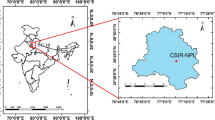Abstract
We attempted to elucidate seasonal variations in fossil-fuel-derived carbon (FC) and biomass-derived carbon (BC) in urban atmospheric aerosols. We undertook continuous measurements of the composition of fine particle (PM2.1) in central Tokyo, including the 14C/12C ratio. The percent modern carbon (pMC) contained in all samples averaged 43, and the highest was 54 in late December and the lowest was 31 in early August. From the observed carbonaceous component concentrations and the pMC we could calculate the content ratio of FC and BC in PM2.1 and investigate their seasonal variations. Although there was almost no seasonal variation in the ratio of FC, the ratio of BC was observed to rise in early winter. This indicates that FC is influenced by the emission sources without seasonal variations (such as automobiles driven in urban areas). Furthermore, there is significant correlation between BC and organic carbon (OC), and even for urban areas, it is considered that the contribution of biomass carbon to OC in PM2.1 is high.




Similar content being viewed by others
References
Chow, J. C., Watson, J. G., Pritchett, L. C., Pierson, W. R., Frazier, C. A., & Purcell, R. G. (1993). The DRI thermal/optical reflectance carbon analysis system: Description, evaluation and applications in U. S. air quality studies. Atmospheric Environment, 27A, 1185–1201.
Hasegawa, S., Wakamatsu, S., & Tanabe, S. (2005). Comparison of particulate carbon analysis between the thermal method and the thermal/optical method using the same ambient samples. Journal of Japan Society for Atmospheric Environment, 40, 181–192. (in Japanese).
Kumata, H., Sakuma, E., Uchida, T., Fujiwara, K., Tsuzuki, M., Uchida, M., et al. (2006). Compound class specific 14C analysis of polycyclic aromatic hydrocarbons associated with PM10 and PM1.1 aerosols from residential areas of suburban Tokyo. Environmental Science & Technology, 40, 3474–3480.
Lewis, C. W., & Stiles, D. C. (2006). Radiocarbon content of PM2. 5 ambient aerosol in Tampa, FL. Aerosol Science and Technology, 40, 189–196.
Lewis, C. W., Klouda, G. A., & Ellenson, W. D. (2004). Radiocarbon measurement of the biogenic contribution to summertime PM-2.5 ambient aerosol in Nashville, TN. Atmospheric Environment, 38, 6053–6061.
Minoura, H., Takahashi, K., Chow, J. C., & Watson, J. G. (2006). Multi-year trend in fine and coarse particle mass, carbon, and ions in downtown Tokyo, Japan. Atmospheric Environment, 40, 2478–2487.
Rogge, W. F., Hildemann, L. M., Mauzrek, M. A., Cass, G. R., & Simoneit, B. R. T. (1993). Sources of fine organic aerosol. 2. Noncatalyst and catalyst-equipped automobiles and heavy-duty diesel trucks. Environmental Science & Technology, 27, 636–651.
Saitoh, K., Sera, K., Hirano, K., & Shirai, T. (2002). Chemical characterization of particles in winter-night smog in Tokyo. Atmospheric Environment, 36, 435–440.
Sakamoto, K., Wang, Q., Kimijima, K., Okuyama, M., Mizuno, T., Yoshikado, H., et al. (1994). Spatial distributions of ambient aerosol acidity in early winter at South-Kanto area, Japan. Environmental Science, 7, 237–244.
Shibata, K., Endo, M., Yamamoto, N., Yoshinaga, J., Goto, S., Yoneda, M., et al. (2004). Temporal variation of radiocarbon concentration in airborne particulate matter in Tokyo. Radiocarbon, 46, 485–490.
Tokyo Environmental White Paper 2006 (2006). The Bureau of the Environment. Tokyo Metropolitan Government, pp. 56. (in Japanese).
Acknowledgements
We received valuable advice concerning analysis of radiocarbon from Dr. Minoru Yoneda of the National Institute for Environmental Studies. We take the opportunity to thank him here. This study in part was supported by the Japan Science and Technology Agency through its Cooperative System for Supporting Priority Research, and Global Environmental Research Fund (Code No. C-061) from Ministry of Environmental of Japan.
Author information
Authors and Affiliations
Corresponding author
Rights and permissions
About this article
Cite this article
Takahashi, K., Hirabayashi, M., Tanabe, K. et al. Radiocarbon Content in Urban Atmospheric Aerosols. Water Air Soil Pollut 185, 305–310 (2007). https://doi.org/10.1007/s11270-007-9454-5
Received:
Accepted:
Published:
Issue Date:
DOI: https://doi.org/10.1007/s11270-007-9454-5




